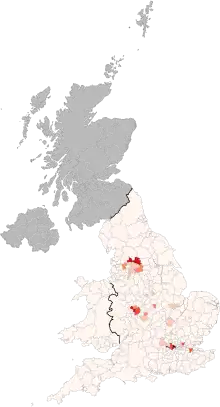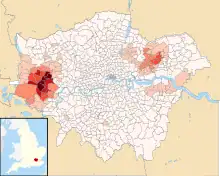British Punjabis
British Punjabis are citizens or residents of the United Kingdom whose heritage originates wholly or partly in the Punjab, a region in the Indian subcontinent, which is divided between India and Pakistan. Numbering 700,000 in 2006, Punjabis represent the largest ethnicity among British Asians. They are a major sub-group of the British-Indian and British Pakistani communities.[2]
| Part of a series on |
| Punjabis |
|---|
 |
_with_cities.png.webp) Punjab portal |
 Distribution by regional area | |
| Total population | |
|---|---|
| 700,000 (2006)[1] | |
| Regions with significant populations | |
| Mainly England · Smaller communities in Scotland, Wales and Northern Ireland | |
| Languages | |
| English · Punjabi · Hindi · Urdu · Bagri · Pothwari · Pahari | |
| Religion | |
| Sikhism · Hinduism · Islam · Christianity | |
| Related ethnic groups | |
| Punjabi diaspora · British Indians · British Pakistanis · British Mirpuris |
History
The United Kingdom is home to the largest Punjabi diaspora after Canada.[2] Immigration from the Punjab region to the UK began during the colonial era, when Punjab was a province of British India. Punjabi migrants in the nineteenth and early twentieth centuries were mainly domestic servants, seamen working on British merchant ships and visiting civil servants or students seeking professional qualifications.[2] A notable early figure was Duleep Singh, former Maharajah of the Sikh Empire, who was exiled to Britain in 1853.[2] His daughter Sophia Duleep Singh became a prominent suffragette and a pioneer of women's rights in Britain.[3]
The first significant Punjabi migration began in the 1950s when labour shortages in the UK following the Second World War led the British administration to encourage recruitment from across the Commonwealth.[4][5] The vast majority of these migrants were men from India and Pakistan, who after a period of acclimatisation began to settle permanently and invite their friends, wives and children to join them.[6] These migrants often found work in the manufacturing, textile and service sectors, including a significant number at Heathrow Airport.[7] The town of Southall in west London became an early hub for Punjabi migrants, and would become the country’s premier British Asian town, dubbed Little Punjab.[8]
In the 1970s, there was widespread migration of Punjabis from East Africa, many of whom had retained their British passports following the independence of Kenya and Uganda. East African Punjabis are known as twice migrants, and came to the UK amidst growing discrimination at home, symbolised by the Expulsion of Asians from Uganda in 1972.[9] Unlike earlier Punjabi migration to the UK, East African Punjabis migrated as families. Many were successful businessmen or professionals with savings and able to adjust quickly to life in Britain.[10]
Demographics

In the 2011 UK Census, 273,000 people identified Punjabi as their first language. Of these, 271,000 were in England, 23,000 in Scotland, 1,600 in Wales and a smaller number in Northern Ireland.[11][12] Thus, Punjabi is the third most commonly spoken language in the UK.[13] The Southall area of Greater London is home to a significant Punjabi population.[2] The total population of Punjabis in the UK is estimated to exceed 700,000.[1]
Immigrants from the Pakistani province of Punjab are mainly Punjabi Muslims, with smaller numbers of Christians.[14] The majority originate from the northern and central parts of Punjab, such as: Pothwar, Rawalpindi, Attock, Chakwal, Jhelum, Jhang, Faisalabad, Gujranwala, Gujrat, Chiniot, Sargodha, Toba Tek Singh and Lahore.[15][16] Punjabis are estimated to comprise one-third of the British Pakistani population, making up the second largest sub-group after Mirpuri Kashmiris.[17] The tribes to which British Pakistani Punjabis belong include Jats, Gujjars, Awans, Arains, Rajputs and several others like Pathans of Punjab and Kashmiris of Punjab.[18]
The population of Indian Punjabis in the UK has been estimated at 466,563 in 2011, based on an earlier estimate that they constitute 45% of the British Indian community. Of these, majority are Sikhs while the rest are mainly Punjabi Hindus.[2][15] The areas where they predominately originate from are Jalandhar, Amritsar, Ludhiana, Kapurthala, Bathinda, Hoshiarpur, Nawanshahr and Moga. The UK has the second largest Sikh diaspora outside India, after Canada.[2]
Culture
Punjabi culture strongly defines the identity of British Punjabis. The bhangra form of music was popularised by Punjabi immigrants in the UK during the 1970s.[19] England has long been associated with the Asian Underground scene which gave rise to Punjabi pop music, especially among the younger generations.[20] Punjabi cuisine is also highly popular in the country.[21] Chicken tikka masala has been called a "national dish" of Britain.[22]
Punjabis are known for their entrepreneurial activities.[23] Research by Teesside University shows that the British Punjabi community is one of the most highly educated and successful in the UK.[24] Notable businesspeople include Surinder Arora who ranks amongst the wealthiest Britons.[25][26] Other Punjabis have achieved notability in the theatres of British politics, sports and entertainment.[27]
See also
Notes
References
- McDonnell, John (5 December 2006). "Punjabi Community". House of Commons. Retrieved 3 August 2016.
We now estimate the Punjabi community at about 700,000, with Punjabi established as the second language certainly in London and possibly within the United Kingdom.
- Chanda, Rupa; Ghosh, Sriparna (2013). "The Punjabi Diaspora in the UK: An Overview of Characteristics and Contributions to India" (PDF). CARIM INDIA – Developing a knowledge base for policymaking on India-EU migration. Archived from the original (PDF) on 4 March 2016. Retrieved 3 August 2016.
- "Princess Sophia Duleep Singh – Timeline". History Heroes organization.
- Pirkko Pitkänen, Ahmet İçduygu, Deniz Sert (2012), Migration and Transformation:: Multi-Level Analysis of Migrant Transnationalism, Springer Science & Business Media, page 22
- Thaker, Aruna; Barton, Arlene (2012). Multicultural Handbook of Food, Nutrition and Dietetics. John Wiley & Sons. p. 30. ISBN 9781405173582.
- Thandi, S.S. (2015) ‘Punjabi Migration, Settlement and Experience in the UK’, in Rajan, S.I., Varghese, V.J., and Kumar Nanda, A. (eds.) Migration, Mobility and Multiple Affiliations: Punjabis in a Transnational World. Cambridge: Cambridge University Press, pp. 105–130.
- Striking Women.org. "Post 1947 migration to the UK". Retrieved 28 October 2018.
- The Guardian (4 April 2018). "Southall became Little Punjab". Retrieved 28 October 2018.
- Bizeck J.Phiri. "Asians: East Africa". Retrieved 20 February 2011.
- Siobhan Laird (2008), Anti-Oppressive Social Work: A Guide for Developing Cultural Competence, SAGE, page 52
- Rogers, Simon (31 January 2013). "Census 2011: the language data visualised". The Guardian. Retrieved 5 August 2016.
- "Scotland's Census 2011 - National Records of Scotland: Language used at home other than English (detailed) - All people aged 3 and over" (PDF). Scotland Census. Archived from the original (PDF) on 15 February 2020. Retrieved 5 August 2016.
- "2011 Census: Quick Statistics". Office for National Statistics. Retrieved 17 May 2014.
- "2011 census data – religion". The Guardian. 16 May 2013. Retrieved 29 August 2013.
- Heath, Anthony F.; Fisher, Stephen D.; Rosenblatt, Gemma; Sanders, David; Sobolewska, Maria (2013). The Political Integration of Ethnic Minorities in Britain. OUP Oxford. p. 23. ISBN 9780199656639.
- Gilliat-Ray, Sophie (2010). Muslims in Britain. Cambridge University Press. p. 45. ISBN 9780521536882.
- Roger Ballard; Marcus Banks (1994). Desh Pardesh: the South Asian presence in Britain. C. Hurst & Co. Publishers. pp. 18, 20, 21.
- Monika Böck; Aparna Rao (2000). Culture, Creation, and Procreation: Concepts of Kinship in South Asian Practice. Berghahn Books. pp. 81–157. ISBN 1-57181-912-6.
... Kalesh kinship is indeed orchestrated through a rigorous system of patrilineal descent defined by lineage endogamy
- Fisher, Michael Herbert (2007). A South-Asian History of Britain: Four Centuries of Peoples from the Indian Sub-continent. Greenwood World Publishing. ISBN 9781846450082.
- "History of Desi Music". BBC Asian Network. Retrieved 3 August 2016.
- Panjabi, Camellia (1995). The Great Curries of India. Simon and Schuster. p. 10. ISBN 9780684803838.
- "Robin Cook's chicken tikka masala speech: Extracts from a speech by the foreign secretary to the Social Market Foundation in London". Guardian. 19 April 2001.
- Jones, Marian; Dimitratos, Pavlos (2014). Emerging Paradigms in International Entrepreneurship. Edward Elgar Publishing. p. 90. ISBN 9781845420635.
- Steve Taylor. "Punjabi Communities in the North East". Teesside University. Archived from the original on 2011-09-27. Retrieved 2 November 2010.
- Midgley, Dominic (21 July 2014). "Anwar Pervez: The Billionaire cash and carry King". Express. Retrieved 13 July 2015.
- Teather, David (18 August 2007). "The Mr Nice Guy of the hotels world". The Guardian. Retrieved 3 August 2016.
- Hazelwood, Rajbir Purewal (15 May 2013). "A Diasporic Politics of Belonging: Punjabis in Postwar Britain". Washington University. doi:10.7936/K7DJ5CKJ. Retrieved 3 August 2016.